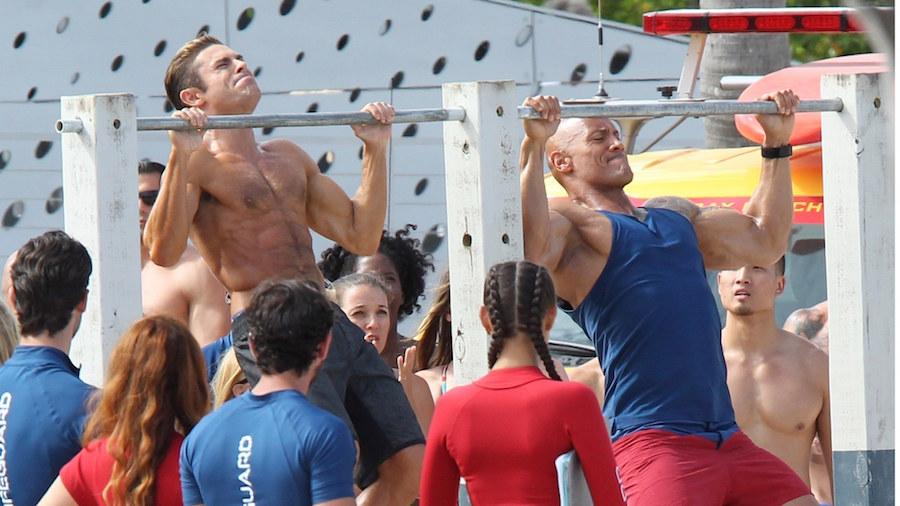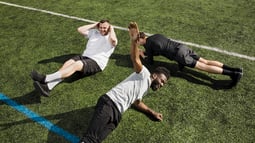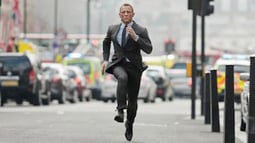

Horace’s programme for a beach body
Photos Reserved rights
Words Gino Delmas
Share the article on
Be #beachready in 6 weeks.
The temperature is rising and we’re witnessing this season’s first sunburns. We’re not quite there yet, but it looks like summer is here to stay. Also here to stay are the few extra kilos you didn’t think you’d still have come beach season. And because you’re not the only one in this situation, gyms are packed to the brim.
The countdown has started, and the most organised among you have already planned their trip to Ibiza (and hence the appropriate exercise regimen). As for the others, there’s not a second more to waste.
The good news is Horace is here to save the day. We’ve prepared a detailed guide to help you get as close as possible to the beach body you’re (sometimes very well) hiding. We talked to Arthur Sene, a strength and conditioning coach, and John Martins, a fitness coach at Dynamo sport club in Paris and nutrition expert, who kindly assisted in preparing the following training and nutrition programme. See you in 6 weeks. Until then, give it all you’ve got.
Your training programme, by Arthur Sene:
“In terms of equipment, you’ll need chairs (or stools / parallettes), a mat or towel for ground and abdominal exercises, a pull-up bar, two dumbbells, and one wooden broom (or a sturdy wooden bar)”.
SESSION #1 - Chest/triceps/shoulders
This session is short but intense.
Start by warming up and doing some dynamic stretches: wrist, hip, arm, pelvis and neck mobility exercises.
1) Diamond push-ups - triceps
Begin with 4 sets of 10 to 15 diamond push-ups. These are like regular push-ups, except your hands are placed closed together with thumbs and index fingers touching, forming a diamond-like shape. Make sure your hands are as close together as possible, so as to really target your triceps. Resting times should be short, between 45 seconds and 1 minute.
2) Dips - chest
Move on to 4 sets of 10 to 15 dips. Try to go all the way down for each repetition to thoroughly work your muscles. Again, resting times should be short, between 45 seconds and 1 minute.
3) Standard push-ups - chest
Do 4 sets of standard push-ups. Do as many push-ups as possible for your first set. Then rest for 1 minute and 30 seconds. Do 20 push-ups in your second set, followed by a 1-minute rest. Do 20 push-ups for your third set, and rest 30 seconds. Do 20 push-ups for the fourth and final set, followed by a 2-minute rest.
4) One-minute push-up - chest, arms
Next up is the “One-minute push-up”. Start your timer and do just one push-up in 1 minute. You will have to move very slowly down and then back up (approx. 30 seconds for each). Extremely slowly. However, make sure to never stop moving throughout the entire minute.
5) Dumbbell lateral raises - shoulders
The last exercise for this session is dumbbell lateral raises (both arms simultaneously). Do 4 sets of 10 to 12 repetitions, arms straight along your body, making sure to control the movement on the way down. For more or less difficulty, adjust each dumbbell’s weight and the rest time between sets (1 minute for experienced athletes to 1 minute and 30 seconds for beginners).
SESSION #2 – Abs/legs
Abs
1) Scissor kicks - legs, abs
Do this exercise for 5 minutes, alternating between rest and exercise every 30 seconds. The aim is to get the coveted V-cut. Lie on your back with your arms by your sides, and start moving your legs horizontally to create the scissoring action. “Legs must be kept very straight, and move quickly”. Adjust the alternating frequency to increase the level of difficulty. For example; you can exercise for 35 seconds, resting only for 25.
Rest for 1 minute after this exercise.
2) Ab exercises - abs
Choose 4 different ab exercises, such as crunches, V-sits, rowers, oblique crunches, or bicycle crunches. Do 2 sets of 30 seconds each for the exercises you’ve chosen. Once you’re done, do another set of the exercise which you found most difficult.
3) Planks - abs, stability
Time to move on to planks, which strengthen your core muscles and improve your upper and lower body stability. Hold a plank for 1 minute, then 1 minute more in a “straight arm” position (push-up starting position). Move on to side planks, holding 45 seconds on each side. You will have reached a grand total of 3 minutes and 30 seconds. Resting time between each exercise should be adjusted for varying difficulty, but the aim is to keep it as low as possible. For example, beginners can rest up to 1 minute, while experienced athletes should need only 15 seconds. The bravest (and most impressive) among you will attempt it without resting at all.
4) Bridges - legs
Follow with 5 sets of 20 glute bridges, with 30-second rest periods between each set. Lay on your back with your legs folded up and thrust your hips towards the ceiling.
Legs
1) 1) Squats - thighs, glutes
Warm up: Start with 10 unweighted squats, and rest for 30 seconds. Do another 20 unweighted squats, and rest for another 30 seconds.
You can now start adding weights, for example by filling a backpack with books or full water bottles.
Do 5 sets of 20 to 25 squats, with 30 seconds to rest between each set. Adjust the amount of weight in your backpack to increase/reduce difficulty.
2) Lunges - thighs, glutes, hamstring
Warm up: Start with 10 unweighted lunges, and rest for 30 seconds. Do another 20 unweighted lunges, and rest for another 30 seconds.
Add weights to your backpack and do 5 sets of 20 to 25 lunges based on the amount of weight you are carrying, rest for 30 seconds between each set.
SESSION #3 - Back/biceps
Start by warming up and doing some dynamic stretches: wrist, hip, arm, pelvis and neck mobility exercises.
1) Biceps curl - Biceps
Do 4 sets of 10 to 12 curls with the dumbbells. Adjust the amount of weight on the dumbbells, and resting time (between 1 and 1 minute and 30 seconds).
2) 2) Pull-ups - biceps, lats
Do 1 pull-up then rest 30 seconds, followed by 2 pull-ups then 30 seconds’ rest, 3 pull-ups, etc. Keep going until you reach your maximum amount of pull-ups. Rest for 2 to 2 minutes and 30 seconds based on your level. Follow up with 2 sets of your maximum amount of repetitions with 1 minute and 45 seconds rest between both sets. Beginners should opt for supinated pull-ups, and experienced athletes pronated pull-ups.
3) 3) Inverted rows - trapezius, back
Put the broom or bar between two chairs, relatively high if possible. Lie below and pull your body upwards. Do 4 sets of 12 reps, with 1 minute rests between sets.
SESSION #4 (optional)
Repeat the session which you found most difficult or the session which will exercise the muscles you most want to work.

Advice on nutrition, by John Martins:
“When the aim is to burn fat, I recommend working out in the morning, on an empty stomach. Lipolysis is quicker to start in the morning, with the body having used its glucose reserves during the night to regulate the metabolism. However, you must be used to training, and it could prove to be complicated for people who are out of practice. In this case, I recommend eating some sugar, which will help fuel the session.
If you are planning on doing an intensive session, stay away from milk, which is complicated to digest, and instead eat half of a crushed banana, or a cereal bar. The same goes for water, drink small quantities every 5 to 6 minutes, and wait until you’ve finished training to drink more. Add a little grape juice to your water for your session; it will provide some easy-to-absorb sugar.”
Lunch
“Vegetables are the most important part of this meal. Eat as many vegetables as you want. If you’re not too fond of them, they can be replaced with cold-pressed juices. Cold-pressing (as opposed to the usual centrifugal pressing process) ensures all nutrients remain in the juice, which is extremely important when you train regularly.
Taking in consideration your level of daily physical activity, you can also add carbs (pasta, rice, if possible brown). If it’s an off day, and you are not planning on doing any physical activity, you don’t have to add any carbs to your meal. You can add animal or vegetal proteins, based on your digestive capacity. It should be noted, however, that proteins aren’t digested as quickly as carbs. Protein is absorbed in eight to nine hours, while the body only needs four to five hours to digest carbs. This may cause some bloating. Lunch is the most important meal of the day, so don’t starve yourself. Eat large enough portions to help you through the rest of your (active) day. Lunch, like breakfast, loads your body with nutrients.”
Dinner
“Vegetables are compulsory, as they have high mineral content, which facilitates regeneration. If you’ve had a long, busy day, feel free to add some carbs. The most important factor is balance. If you eat too much, your body’s energy will be consumed by your digestion, whereas eating smaller portions in the evening ensures your energy will be used to regenerate your metabolism. Adjust your portions based on your digestive process and physical activity.”
Snackq
“My little secret. They’re super important. I have one after my morning training, but snacks in the afternoon are also very healthy. If your session is at 7:00pm, have your snack at 4:00pm. I recommend Acai bowls (frozen acai, raw granola, goji berries) or Miam-Ô-Fruits: flaxseed, pumpkin seed, chia seed, half a banana, and honey. It’s a raw food approach, none of the ingredients are processed. It’s very healthy, quick and easy, to digest. These snacks will provide the energy you need without being too heavy on the stomach.
In the summer, when it gets hot, you can replace your usual snacks with fruit. The best option being watermelon, which has a very low calorie count and will keep you hydrated. It’s important to treat yourself too, with smoothies, fruit and ice cream, without going over the top, because once the fibres have been crushed, glucose spreads quickly and can provoke hypoglycaemia. It’s important for morale though, in particular after a few weeks of drastic dieting. Add various seeds to slow down the glucose spreading process.”
In six weeks’ time, if you stick to this programme, you’ll look and feel your best to enjoy your holidays. No pain, no gain, as they say.




